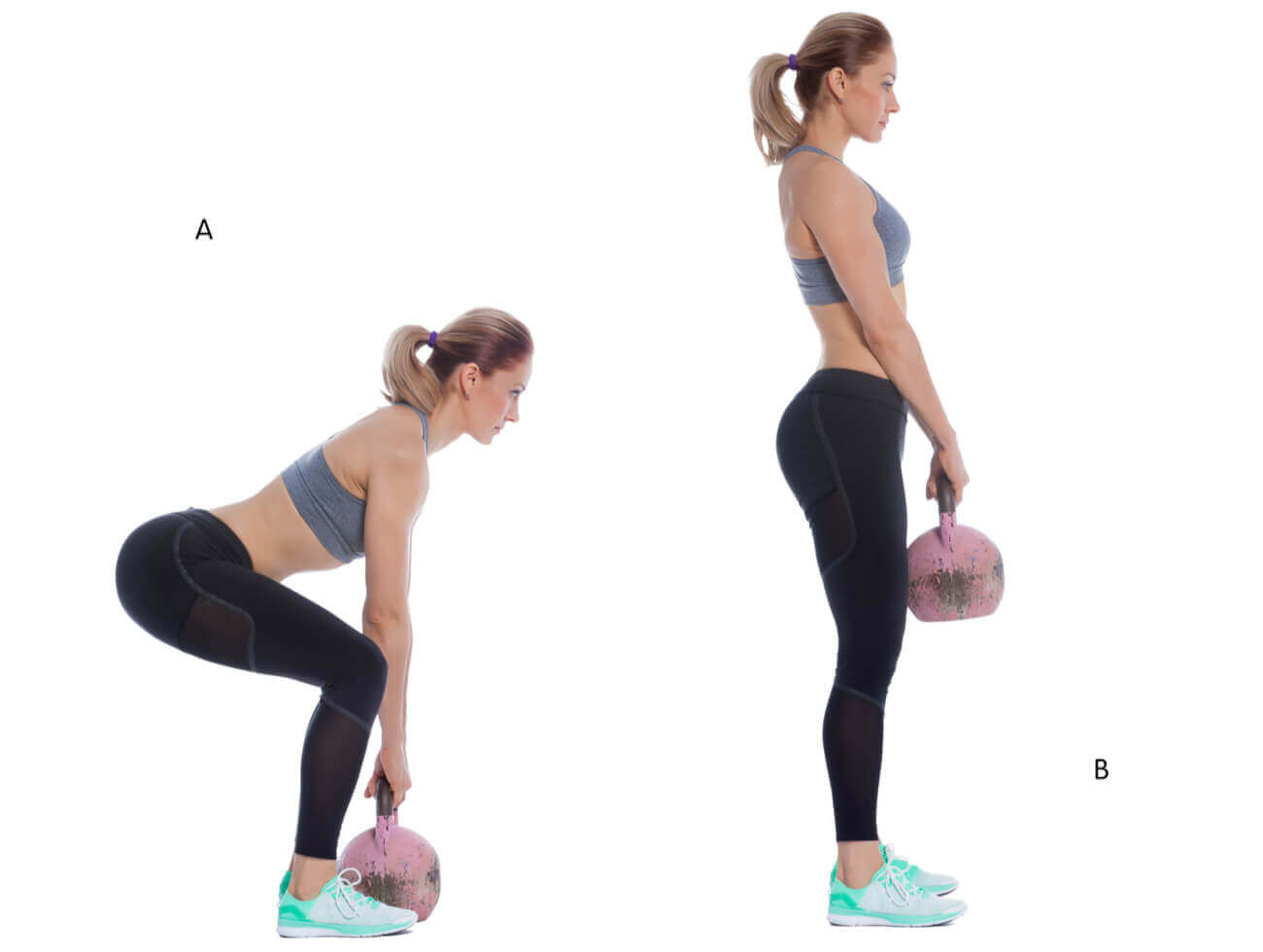4 Kettlebell Exercises to Work the Back

Working your back with kettlebell exercises is possible, as long as you do the right exercises. Keep in mind that, beyond stimulating the different muscle groups of the back, you must also perform the correct technique to progress in a timely manner and avoid injury.
Kettlebells are often very useful because of their design. In addition, their weight distribution is appropriate for a better grip. The goal is to take advantage of this and regularly include exercises to work the back.
Working the back with kettlebell exercises
Having said that, we’ll teach you a series of exercises that you can do with a kettlebell to stimulate the back area of the torso. Remember, the number of sets and repetitions will be determined by your routine, which should be adjusted to your needs and goals.
Deadlift with a kettlebell

When we talk about deadlifts, we’re referring to an exercise that focuses on the development of the lower extremities. However, thanks to the hip extension movement and the kettlebell, the back muscles are activated and stimulated considerably. The execution technique is as follows:
- Stand upright, legs slightly wider than shoulder-width apart, and place the kettlebell between the middle of your feet for a good grip.
- Semi-flex at the knees and hips, keep your back straight and your eyes straight ahead. Once in position, grab the kettlebell.
- With the kettlebell in your hands, lower yourself down with a slight bend in your knees and your back straight. Contract your abdomen and lower back and try to get the kettlebell to touch the floor.
- To return to the starting position, push off the floor with your legs and lower back.
- Concentrate on technique and perform the corresponding number of repetitions.
High pull-ups with kettlebell exercises
High pull-ups are one of the best exercises for working the back with kettlebells. You can accompany them with deadlifts, so they become a great compound exercise. Or you can do them completely alone.
- Stand with your legs shoulder-width apart and place the kettlebell in the middle of your feet, just like in the starting position of the deadlift.
- Grasp the kettlebell with both hands while semi-flexing your hips and knees, then perform the extension of both joints.
- When fully standing, bring the kettlebell to chin level while raising the elbows just above the shoulders.
- Return back down and allow the kettlebell to touch the floor. Do the number of repetitions indicated in the routine.
Kettlebell exercises: rowing

- Stand with your legs shoulder-width apart. Place the kettlebell between your feet, but level with your toes.
- Semi-flex your legs and hips, keep your back straight with your torso leaning forward and your eyes straight ahead. Lower and grasp the kettlebell with one hand.
- Bring the kettlebell toward your hips while bending your arm at a 45-degree angle. Do the programmed number of repetitions and, when finished, perform the exercise with the other arm.
Kettlebell grinder

- Stand with your legs shoulder-width apart.
- Bend at the hips as you bring your torso forward and grasp the kettlebell with your right hand.
- Lift the kettlebell with your arm fully extended overhead.
- Without letting the kettlebell come down at any time, bring the other hand toward the floor, but make a slow-motion movement until it touches the left foot.
- Go back up and do the planned number of repetitions.
- When you finish, change your grip on the kettlebell from the right hand to the left and repeat the exercise.
Working the back with kettlebells, a matter of technique
Kettlebells can be very useful for working various muscle groups of the body. However, it’s most advisable to place emphasis on technique before developing a routine with this element.
The main advice revolves around improving, avoiding injury, and achieving the proposed goals. Many people tend to have bad grips or perform improper movements with kettlebells, and this can generate more harm than good.
Working your back with kettlebell exercises is possible, as long as you do the right exercises. Keep in mind that, beyond stimulating the different muscle groups of the back, you must also perform the correct technique to progress in a timely manner and avoid injury.
Kettlebells are often very useful because of their design. In addition, their weight distribution is appropriate for a better grip. The goal is to take advantage of this and regularly include exercises to work the back.
Working the back with kettlebell exercises
Having said that, we’ll teach you a series of exercises that you can do with a kettlebell to stimulate the back area of the torso. Remember, the number of sets and repetitions will be determined by your routine, which should be adjusted to your needs and goals.
Deadlift with a kettlebell

When we talk about deadlifts, we’re referring to an exercise that focuses on the development of the lower extremities. However, thanks to the hip extension movement and the kettlebell, the back muscles are activated and stimulated considerably. The execution technique is as follows:
- Stand upright, legs slightly wider than shoulder-width apart, and place the kettlebell between the middle of your feet for a good grip.
- Semi-flex at the knees and hips, keep your back straight and your eyes straight ahead. Once in position, grab the kettlebell.
- With the kettlebell in your hands, lower yourself down with a slight bend in your knees and your back straight. Contract your abdomen and lower back and try to get the kettlebell to touch the floor.
- To return to the starting position, push off the floor with your legs and lower back.
- Concentrate on technique and perform the corresponding number of repetitions.
High pull-ups with kettlebell exercises
High pull-ups are one of the best exercises for working the back with kettlebells. You can accompany them with deadlifts, so they become a great compound exercise. Or you can do them completely alone.
- Stand with your legs shoulder-width apart and place the kettlebell in the middle of your feet, just like in the starting position of the deadlift.
- Grasp the kettlebell with both hands while semi-flexing your hips and knees, then perform the extension of both joints.
- When fully standing, bring the kettlebell to chin level while raising the elbows just above the shoulders.
- Return back down and allow the kettlebell to touch the floor. Do the number of repetitions indicated in the routine.
Kettlebell exercises: rowing

- Stand with your legs shoulder-width apart. Place the kettlebell between your feet, but level with your toes.
- Semi-flex your legs and hips, keep your back straight with your torso leaning forward and your eyes straight ahead. Lower and grasp the kettlebell with one hand.
- Bring the kettlebell toward your hips while bending your arm at a 45-degree angle. Do the programmed number of repetitions and, when finished, perform the exercise with the other arm.
Kettlebell grinder

- Stand with your legs shoulder-width apart.
- Bend at the hips as you bring your torso forward and grasp the kettlebell with your right hand.
- Lift the kettlebell with your arm fully extended overhead.
- Without letting the kettlebell come down at any time, bring the other hand toward the floor, but make a slow-motion movement until it touches the left foot.
- Go back up and do the planned number of repetitions.
- When you finish, change your grip on the kettlebell from the right hand to the left and repeat the exercise.
Working the back with kettlebells, a matter of technique
Kettlebells can be very useful for working various muscle groups of the body. However, it’s most advisable to place emphasis on technique before developing a routine with this element.
The main advice revolves around improving, avoiding injury, and achieving the proposed goals. Many people tend to have bad grips or perform improper movements with kettlebells, and this can generate more harm than good.
All cited sources were thoroughly reviewed by our team to ensure their quality, reliability, currency, and validity. The bibliography of this article was considered reliable and of academic or scientific accuracy.
- Lopez Miñarro, P. Á. (2009). Ejercicios para el fortalecimiento de la musculatura lumbar. Facultad de Educación. Universidad de Murcia, 1997.
- Fd, F. D. (2018). Calentamiento muscular en la prevención de lesiones músculo-esqueléticas. Ángel Martínez García.
This text is provided for informational purposes only and does not replace consultation with a professional. If in doubt, consult your specialist.








